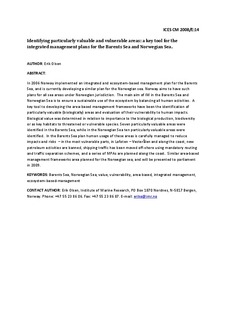Identifying particularly valuable and vulnerable areas: a key tool for the integrated management plans for the Barents Sea and Norwegian Sea.
Working paper

Åpne
Permanent lenke
http://hdl.handle.net/11250/102682Utgivelsesdato
2008Metadata
Vis full innførselSamlinger
Originalversjon
This report is not to be quoted without prior consultation with the General Secretary.Sammendrag
In 2006 Norway implemented an integrated and ecosystem-based management plan for the Barents Sea, and is currently developing a similar plan for the Norwegian sea. Norway aims to have such plans for all sea areas under Norwegian jurisdiction. The main aim of IM in the Barents Sea and Norwegian Sea is to ensure a sustainable use of the ecosystem by balancing all human activities. A key tool to developing the area-based management frameworks have been the identification of particularly valuable (biologically) areas and evaluation of their vulnerability to human impacts. Biological value was determined in relation to importance to the biological production, biodiversity or as key habitats to threatened or vulnerable species. Seven particularly valuable areas were identified in the Barents Sea, while in the Norwegian Sea ten particularly valuable areas were identified. In the Barents Sea plan human usage of these areas is carefully managed to reduce impacts and risks – in the most vulnerable parts, in Lofoten – Vesterålen and along the coast, new petroleum activities are banned, shipping traffic has been moved off-shore using mandatory routing and traffic separation schemes, and a series of MPAs are planned along the coast. Similar area-based management frameworks area planned for the Norwegian sea, and will be presented to parliament in 2009. KEYWORDS: Barents Sea, Norwegian Sea, value, vulnerability, area-based, integrated management, ecosystem-based-management